Embarking on the journey of celestial observation is a truly enriching experience, akin to discovering a new culture or exploring an uncharted territory. For many, this adventure begins with the first look through an amateur telescope. Whether you dream of spotting distant galaxies, admiring the intricate craters of the Moon, or simply connecting with the vastness of the cosmos from your backyard or a dark sky site, finding the right amateur telescope is the crucial first step. This guide, crafted for budding astronomers and seasoned hobbyists alike, cuts through the technical jargon to help you select the perfect instrument to unlock the wonders of the night sky, ensuring your explorations are as breathtaking as any journey across the globe.
Navigating the world of telescopes can feel overwhelming initially, with countless models, specifications, and price points. Our aim is to simplify this process, offering expert insights based on hands-on testing and real-world performance. We’ve reviewed a range of amateur telescope options, from budget-friendly entry points to more advanced systems, considering factors like ease of use, observational power, portability, and overall value. Join us as we explore some of the top contenders for the best amateur telescope in 2025, helping you make an informed decision that will illuminate your nocturnal adventures.
Recommended Amateur Telescopes for 2025
Choosing the right amateur telescope depends heavily on your skill level, budget, and what you primarily want to observe. Here are some of our top recommendations, catering to different needs within the amateur astronomy community.
Best Amateur Telescope for Beginners: Celestron NexStar 4SE
Discover the Best of What to Do in Downtown Denver – Your Ultimate Guide
Discover the Best Brunch in Denver – A Local’s Guide
Top 10 Places to Visit in Nevada with Family for an Epic Trip
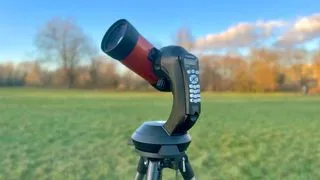 Celestron NexStar 4SE amateur telescope set up in a field under clear skies
Celestron NexStar 4SE amateur telescope set up in a field under clear skies
A great amateur telescope for beginners, the Celestron NexStar 4SE is easy to use and set up, it produces clear and bright images and has a whole host of useful features.
For those just starting out, the Celestron NexStar 4SE stands out as an excellent amateur telescope. Its computerized GoTo mount and SkyAlign technology make finding celestial objects remarkably simple. Instead of manually navigating the night sky, you can select a target from the database, and the telescope automatically points to it and tracks its movement.
Image 2 of 7
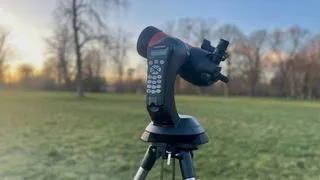 The Celestron NexStar 4SE’s GoTo technology means you can easily find and track specific celestial objects.
The Celestron NexStar 4SE’s GoTo technology means you can easily find and track specific celestial objects.
This Mak-Cassegrain scope boasts a 4-inch (102mm) aperture and 1325mm focal length, providing crisp, bright views ideal for planets and the Moon. While the field of view is somewhat narrow, limiting wide deep-sky object views, it excels at detailed observation of brighter targets. The build quality is solid, though its 23 lbs (10.4 kg) weight and tripod design make it less portable than some other options. Note that its computerized features are power-hungry, so an external power source is highly recommended for longer sessions. This makes it a superb amateur telescope for backyard stargazing.
Image 3 of 7
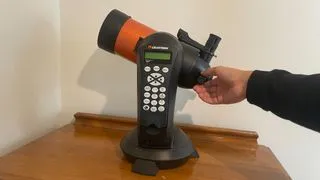 Hand controller for the Celestron NexStar 4SE amateur telescope
Hand controller for the Celestron NexStar 4SE amateur telescope
Specifications:
- Optical design: Maksutov-Cassegrain
- Mount type: Computerized Alt-Azimuth
- Aperture: 4-inches / 102mm
- Focal length: 1325mm
- Highest useful magnification: 241x
- Lowest useful magnification: 15x
- Supplied eyepieces: 25mm
- Weight: 23 lbs (10.44kg) fully assembled
| Attributes | Notes |
|---|---|
| Design | Solid and sturdy build, signature orange colors. |
| Performance | Great for observing the moon and planets. |
| Functionality | Alignment correction can be tricky. |
Best Budget Amateur Telescope: Celestron Inspire 100AZ Refractor
Image 1 of 7
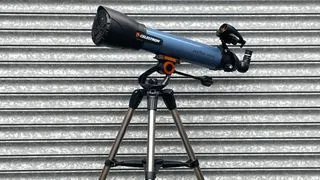 Celestron Inspire 100AZ refractor telescope on a white background with accessories
Celestron Inspire 100AZ refractor telescope on a white background with accessories
The Celestron Inspire 100AZ is a great beginner scope for anyone just getting started with astronomy, it comes with a variety of accessories.
Starting a new hobby like astronomy doesn’t have to break the bank. The Celestron Inspire 100AZ is an affordable amateur telescope that provides a great entry point. It’s a refractor telescope with a 4-inch (100mm) aperture and 660mm focal length, offering clear views of the Moon and planets.
Image 2 of 7
 Close-up of the focusing knob on the Celestron Inspire 100AZ amateur telescope
Close-up of the focusing knob on the Celestron Inspire 100AZ amateur telescope
One clever feature is the lens cap, which doubles as a smartphone adapter for basic astrophotography – perfect for capturing lunar landscapes with your phone. While it lacks GoTo capabilities, requiring manual object location (perhaps with a stargazing app), its simple alt-azimuth mount is easy to maneuver. It’s lightweight (20 lbs / 9.07kg) and comes with useful accessories like two eyepieces, a red LED flashlight (for preserving night vision), and a StarPointer Pro finderscope. Some chromatic aberration (color fringing) is present on very bright objects, and the stock eyepieces might benefit from an upgrade, but for its price, it’s a solid amateur telescope option.
Image 3 of 7
 Red flashlight accessory that slots into the tripod of the Celestron Inspire 100AZ amateur telescope
Red flashlight accessory that slots into the tripod of the Celestron Inspire 100AZ amateur telescope
Specifications:
- Optical design: Refractor
- Mount type: Alt-azimuth
- Aperture: 3.94-inches / 100mm
- Focal length: 660mm
- Highest useful magnification: 241x
- Lowest useful magnification: 15x
- Supplied eyepieces: 10mm, 25mm
- Weight: 20 lbs (9.07kg)
| Attributes | Notes |
|---|---|
| Design | Fairly lightweight. |
| Performance | Excels with lunar views. |
| Functionality | Easy to set up and take down. |
Best Value Amateur Telescope for Enthusiasts: Celestron Astro Fi 130
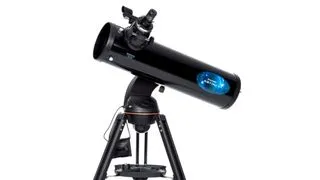 The Celestron Astro Fi 130 Newtonian reflector telescope on a white background
The Celestron Astro Fi 130 Newtonian reflector telescope on a white background
The Celestron Astro Fi 130’s wide field of view will allow you to see large galaxies without having to reposition the telescope often.
As amateur astronomers gain experience, they often seek instruments that offer more capability without a prohibitive price tag. The Celestron Astro Fi 130 is an excellent value proposition in this category. This Newtonian reflector features a 5.19-inch (130mm) aperture and 650mm focal length, providing a wider field of view compared to the 4SE, making it better suited for observing larger deep-sky objects like star clusters and some galaxies, alongside good views of the Moon and planets.
Its key feature is integrated Wi-Fi, allowing control via the Celestron SkyPortal app on your smartphone or tablet. This effectively gives you GoTo capabilities via your mobile device. The app not only controls the motorized mount but also acts as a sky guide, suggesting interesting objects to view based on your location and the time. It’s a great step up for enthusiasts comfortable using technology to enhance their stargazing. The package includes 10mm and 25mm Kellner eyepieces and a red dot finder. While the stock focuser isn’t top-tier and batteries can drain quickly in cold weather (external power recommended), the overall performance and tech integration at its price point make this a compelling amateur telescope for hobbyists.
Specifications:
- Optical design: Newtonian Reflector
- Mount type: Computerized altitude-azimuth single fork
- Aperture: 5.19-inches / 130mm
- Focal length: 650mm
- Highest useful magnification: 307x
- Lowest useful magnification: 19x
- Supplied eyepieces: 25mm and 10mm
- Weight: 18 lbs (8.6kg)
| Attributes | Notes |
|---|---|
| Design | Very sturdy build with well constructed tube and tripod. |
| Performance | Makes use of SkyAlign technology for easy alignment. |
| Functionality | Great for lunar and planetary observing, but some views are fuzzy. |
Best Premium Amateur Telescope: Celestron NexStar Evolution 9.25
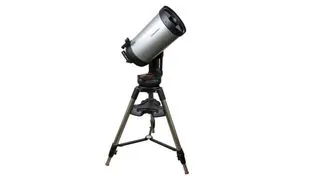 The Celestron NexStar Evolution 9.25 Schmidt-Cassegrain telescope on a tripod
The Celestron NexStar Evolution 9.25 Schmidt-Cassegrain telescope on a tripod
Automatically track objects as they move across the sky with this high-quality Catadioptric telescope.
For the serious amateur astronomer looking to invest in a high-performance instrument, the Celestron NexStar Evolution 9.25 is a top-tier choice. This Schmidt-Cassegrain telescope offers a large 9.25-inch (235mm) aperture and a long 2350mm focal length, providing incredibly detailed and bright views of a wide range of celestial objects, from planets to deep-sky wonders.
Image 1 of 1
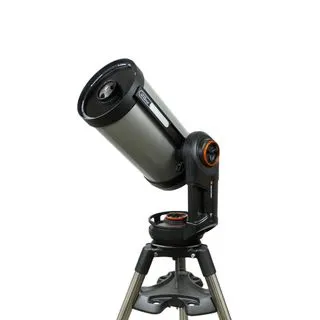 Celestron NexStar Evolution 9.25 telescope and mount displayed on a white background
Celestron NexStar Evolution 9.25 telescope and mount displayed on a white background
It features a robust, computerized alt-azimuth fork arm mount with a built-in rechargeable lithium-ion battery offering up to 10 hours of power – a significant convenience. Control is seamless via the Celestron SkyPortal app, making finding and tracking objects effortless, even for such a powerful scope. While its size and weight (62.60 lbs / 28.39kg) mean it’s best suited for backyard use rather than easy portability, the stunning, crisp views it delivers justify its premium price tag. It’s an investment amateur telescope that can grow with your skills and provide breathtaking observations for years.
Specifications:
- Optical design: Schmidt-Cassegrain
- Mount type: Computerized alt-azimuth fork arm
- Aperture: 9.25-inches / 235mm
- Focal length: 2350mm
- Highest useful magnification: 555x
- Lowest useful magnification: 34x
- Supplied eyepieces: 13mm, 40mm
- Weight: 62.60 lbs (28.39kg)
| Attributes | Notes |
|---|---|
| Design | A bit bulky and tricky to transport. |
| Performance | Crisp views with no defects. |
| Functionality | Motorized mount a good choice for astrophotography. |
Best Amateur Telescope for Astrophotography: Celestron Origin Intelligent Home Observatory
Image 1 of 5
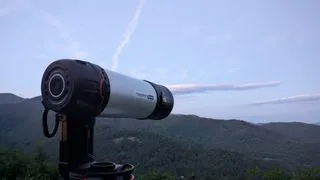 Celestron Origin Intelligent Home Observatory smart telescope set up in a field
Celestron Origin Intelligent Home Observatory smart telescope set up in a field
This smart telescope takes beautiful deep sky photos in just a few seconds, but it’s not an all-rounder telescope.
For the amateur astronomer whose primary passion is capturing images of the cosmos, the Celestron Origin offers a revolutionary approach. This smart telescope, while lacking a traditional eyepiece, features a built-in camera that allows you to view and image the night sky directly on a connected mobile device. Using RASA (Rowe-Ackermann Schmidt Astrograph) optical design, it captures crystal clear deep-sky photos in seconds, automatically stacking images to enhance brightness and detail, even in light-polluted urban environments.
Image 2 of 5
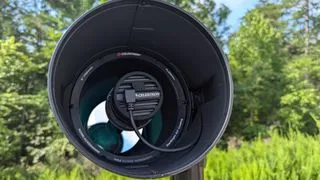 Celestron Origin intelligent home observatory telescope with trees in the background
Celestron Origin intelligent home observatory telescope with trees in the background
Its automated focusing, tracking, and image processing make it incredibly beginner-friendly for astrophotography, requiring little prior knowledge. The accompanying app is intuitive and makes locating and imaging targets effortless. While it’s not ideal for high-magnification planetary visual observation (as you view via a screen), its deep-sky imaging capabilities are outstanding. This pricey, but innovative, instrument represents a significant leap forward in accessible astrophotography for the dedicated amateur.
Image 3 of 5
 Handles on the mount of the Celestron Origin amateur astrophotography telescope
Handles on the mount of the Celestron Origin amateur astrophotography telescope
Specifications:
- Optical design: Rowe-Ackermann Schmidt Astrograph (RASA)
- Mount type: Motorized Alt-azimuth
- Aperture: 6-inches / 152mm
- Focal length: 335mm
- Highest useful magnification: N/A (Digital Zoom up to 400x)
- Lowest useful magnification: N/A (Digital Zoom)
- Supplied eyepieces: N/A
- Weight: 41.6 lbs (18.6 kg)
| Attributes | Notes |
|---|---|
| Design | Bulky, but full of useful features on the mount. |
| Performance | Beautiful, clear photos of deep sky objects. |
| Functionality | Motorized mount, but not a traditional telescope with an eyepiece. |
Best Motorized Amateur Telescope: Celestron NexStar 8SE
Image 1 of 7
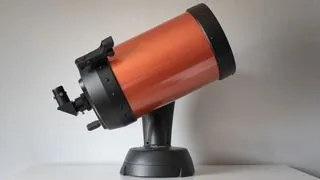 Celestron NexStar 8SE motorized amateur telescope on a tripod
Celestron NexStar 8SE motorized amateur telescope on a tripod
A fantastic scope for any experience level, incredibly easy to use yet powerful enough for deep space exploration and even astrophotography.
The Celestron NexStar 8SE is often hailed as one of the most beloved amateur telescope models, and for good reason. It strikes a superb balance between power, ease of use, and value (though it is a significant investment). Its 8-inch (203mm) Schmidt-Cassegrain optics gather ample light for stunningly bright and detailed views of planets, the Moon, and a wealth of deep-sky objects.
Image 2 of 7
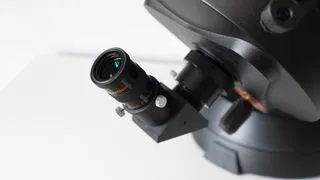 Celestron NexStar 8SE with a 25mm eyepiece
Celestron NexStar 8SE with a 25mm eyepiece
Equipped with a computerized alt-azimuth fork arm mount and the intuitive SkyAlign technology, it’s incredibly easy to set up and navigate the night sky using the included hand controller. This motorized mount also makes it a strong contender for astrophotography, allowing smooth and accurate tracking of celestial targets. Its compact design (thanks to the folded light path of the Schmidt-Cassegrain) enhances portability compared to larger reflectors, making it a versatile amateur telescope suitable for backyard observation or trips to darker sites. While it requires 8 AA batteries (rechargeables recommended), its optical performance and user-friendly automation make it a fantastic choice for dedicated amateurs.
Image 3 of 7
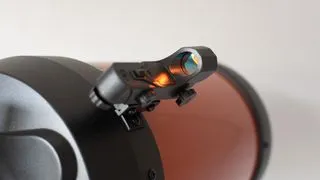 Included basic finderscope on the Celestron NexStar 8SE amateur telescope
Included basic finderscope on the Celestron NexStar 8SE amateur telescope
Specifications:
- Optical design: Schmidt-Cassegrain
- Mount type: Computerized alt-azimuth fork arm
- Aperture: 8-inches / 203mm
- Focal length: 2032mm
- Highest useful magnification: 480x
- Lowest useful magnification: 29x
- Supplied eyepieces: 25mm
- Weight: 32 lbs (14.48kg)
| Attributes | Notes |
|---|---|
| Design | Can be transported as a fully-assembled setup. |
| Performance | Outstanding optics, slightly tricky to align if you’re not used to it. |
| Functionality | Easy to assemble and disassemble. |
Best Portable Amateur Telescope: Celestron Astro Fi 102
Image 1 of 7
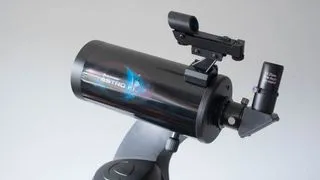 Celestron Astro Fi 102 Maksutov-Cassegrain portable amateur telescope
Celestron Astro Fi 102 Maksutov-Cassegrain portable amateur telescope
The telescope may not be the most attractive, and some might even say it looks a little ‘toyish,’ but the optical quality is good.
For amateur astronomers living in urban areas with significant light pollution, or those who love to explore different locations, portability is key. The Celestron Astro Fi 102 is designed with this in mind. This Maksutov-Cassegrain scope weighs a mere 6 lbs (2.7kg) and has a compact body, making it incredibly easy to transport to darker skies.
Image 2 of 7
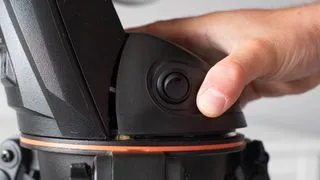 Side view of the portable Celestron Astro Fi 102 amateur telescope
Side view of the portable Celestron Astro Fi 102 amateur telescope
Like the Astro Fi 130, it features integrated WiFi for control via the Celestron SkyPortal app, providing automated GoTo and access to a vast database of celestial objects. While the optics offer good views of the Moon and brighter planets for its size (4-inch/102mm aperture, 1325mm focal length), they might not satisfy more demanding users, with some sharpness drop-off towards the edges. The included tripod is functional but could be sturdier. Despite these minor drawbacks, its combination of portability, computerized features, and affordable price makes it a highly attractive amateur telescope for grab-and-go stargazing adventures.
Image 3 of 7
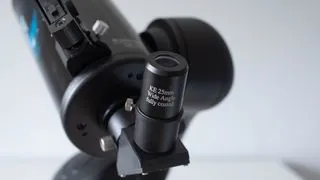 Included 25mm and 10mm eyepieces for the Celestron Astro Fi 102 amateur telescope
Included 25mm and 10mm eyepieces for the Celestron Astro Fi 102 amateur telescope
Specifications:
- Optical design: Maksutov-Cassegrain
- Mount type: Computerized Alt-Azimuth Single Fork Arm
- Aperture: 4.0-inches / 102mm
- Focal length: 1325mm
- Highest useful magnification: Up to 100x with digital zoom
- Lowest useful magnification: 15x
- Supplied eyepieces: 25mm and 10mm
- Weight: 6 lbs (2.7kg)
| Attributes | Notes |
|---|---|
| Design | Highly transportable, but tripod needs weighing down. |
| Performance | Initial setup can be tricky, but after that it’s a breeze. |
| Functionality | Large database of celestial objects on SkyPortal. |
Best Amateur Telescope for Accessories & Versatility: Sky-Watcher Skymax 150 PRO
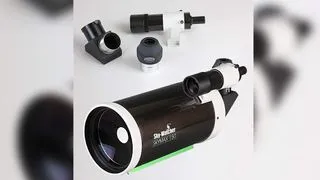 Sky-Watcher Skymax 150 PRO Maksutov-Cassegrain telescope with included accessories
Sky-Watcher Skymax 150 PRO Maksutov-Cassegrain telescope with included accessories
This scope is a great astrophotography all-rounder; you can capture everything from planets to deep-sky subjects.
For the more advanced amateur astronomer who enjoys customizing their setup and venturing into astrophotography, the Sky-Watcher Skymax 150 PRO is a compelling option. This Maksutov-Cassegrain telescope features a 5.90-inch (150mm) aperture and a long 1800mm focal length, delivering outstanding optical quality with sharp, distortion-free views suitable for both visual observation and imaging.
Its strength lies in its compatibility with a wide range of accessories. The package (often sold as the optical tube assembly only, requiring a separate mount and tripod) is designed to accommodate CCD or DSLR cameras, filter wheels, and various other add-ons, making it highly adaptable for different astrophotography goals. Its relatively lightweight optical tube (13.23 lbs / 6kg) means it pairs well with portable equatorial mounts, ideal for travel to dark sky sites. While it typically comes with only one eyepiece, the smooth focuser and excellent performance make it a versatile and rewarding amateur telescope for those ready to build a more specialized setup.
Specifications:
- Optical design: Maksutov-Cassegrain
- Mount type: Equatorial (often paired with EQ-5 Pro or similar)
- Aperture: 5.90-inches / 150mm
- Focal length: 1800mm
- Highest useful magnification: 450x
- Lowest useful magnification: 36x
- Supplied eyepieces: 28 mm (typical)
- Weight: 13.23 lbs (6kg) (Optical Tube Assembly only)
| Attributes | Notes |
|---|---|
| Design | High quality build, excellent optics. |
| Performance | Outstanding optics, with no sign of distortion. |
| Functionality | Great for a wide selection of astrophotography. |
Best Smart Amateur Telescope: Unistellar eQuinox 2
Image 1 of 3
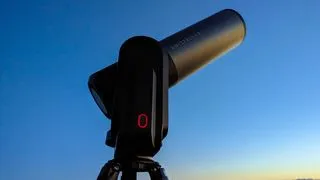 Unistellar eQuinox 2 smart telescope in use against a night sky
Unistellar eQuinox 2 smart telescope in use against a night sky
The Unistellar eQuinox 2 can smoothly and silently slew to night sky objects and image them within minutes of getting it out of the box.
The Unistellar eQuinox 2 represents the cutting edge of smart telescope technology for the amateur market. This Newtonian Reflector doesn’t use traditional eyepieces but instead transmits images captured by its sensitive camera sensor directly to an intuitive smartphone app. Its motorized GoTo alt-azimuth mount and Autonomous Field Detection make setup and object finding incredibly fast and simple – often within minutes of stepping outside.
Image 2 of 3
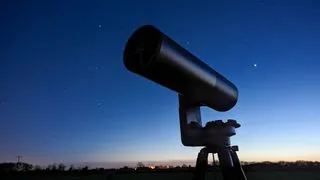 Single power button on the Unistellar eQuinox 2 smart amateur telescope
Single power button on the Unistellar eQuinox 2 smart amateur telescope
A key feature is its Smart Light Pollution Reduction, which digitally enhances views even in urban environments, revealing objects usually hidden by skyglow. The app offers a vast database and real-time image stacking, allowing you to watch faint objects become clearer as the telescope collects more light. While its 6.2MP sensor might not satisfy professional astrophotographers, it provides stunning, accessible views of deep-sky objects for the amateur. It’s a premium, high-tech amateur telescope ideal for those who prioritize ease of use and are comfortable observing via a screen.
Image 3 of 3
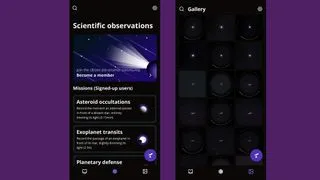 Screenshots of the Unistellar app used to control the eQuinox 2 smart telescope
Screenshots of the Unistellar app used to control the eQuinox 2 smart telescope
Specifications:
- Optical design: Newtonian Reflector
- Mount type: Motorized GoTo alt-azimuth
- Aperture: 4.49-inches / 114mm
- Focal length: 450mm
- Highest useful magnification: 400x digital
- Lowest useful magnification: 50x optical
- Supplied eyepieces: N/A
- Weight: 19.8 lbs (9kg)
| Attributes | Notes |
|---|---|
| Design | Slim, sleek, neat package. |
| Performance | Quick go to location of night sky objects. |
| Functionality | Doesn’t orientate until well after twilight, easy once oriented. |
Best Amateur Telescope for Deep Space: Celestron Advanced VX 8 EdgeHD
Image 1 of 4
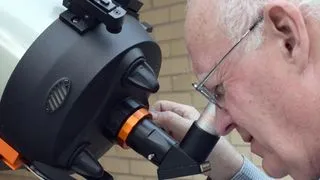 Celestron Advanced VX 8 EdgeHD Schmidt-Cassegrain telescope with Advanced VX mount
Celestron Advanced VX 8 EdgeHD Schmidt-Cassegrain telescope with Advanced VX mount
Intended for serious amateurs, this optically excellent telescope is suitable for all types of visual astronomy with its rugged, lightweight computerized mount.
For the experienced amateur astronomer dedicated to exploring faint, distant objects, the Celestron Advanced VX 8 EdgeHD is a formidable instrument. Its 8-inch (203.2mm) EdgeHD Schmidt-Cassegrain optics are specifically designed to provide pinpoint sharpness across the entire field of view, eliminating the field curvature that can cause stars to blur towards the edges in standard Schmidt-Cassegrain telescopes. This is particularly beneficial for astrophotography.
Image 2 of 4
 Hand controller for the computerized mount of the Celestron Advanced VX 8 EdgeHD amateur telescope
Hand controller for the computerized mount of the Celestron Advanced VX 8 EdgeHD amateur telescope
Paired with the robust and reliable Advanced VX motorized equatorial mount, this telescope offers precise tracking necessary for both high-power visual observation and long-exposure astrophotography of deep-sky objects like galaxies and nebulae. The mount can carry significant weight and features helpful functions like meridian-free imaging. While setting up an equatorial mount requires some understanding of celestial alignment, the computerized GoTo system simplifies finding targets. Weighing 61 lbs (27.67kg), it’s not highly portable but provides exceptional optical performance, making it a worthy investment amateur telescope for serious hobbyists seeking breathtaking views of the universe.
Image 3 of 4
 DSLR camera attached in place of the eyepiece on the Celestron Advanced VX 8 EdgeHD for astrophotography
DSLR camera attached in place of the eyepiece on the Celestron Advanced VX 8 EdgeHD for astrophotography
Specifications:
- Optical design: Schmidt-Cassegrain (EdgeHD)
- Mount type: Motorized equatorial
- Aperture: 8-inches / 203.2mm
- Focal length: 2032mm
- Highest useful magnification: 480x
- Lowest useful magnification: 29x
- Supplied eyepieces: 40mm
- Weight: 61 lbs (27.67kg)
| Attributes | Notes |
|---|---|
| Design | EdgeHD optical design outperforms Schmidt-Cassegrain. |
| Performance | Finds and tracks celestial objects reliably. |
| Functionality | Great views of all types of celestial objects. |
Best Amateur Telescope for Kids: Celestron FirstScope 76 Tabletop Telescope
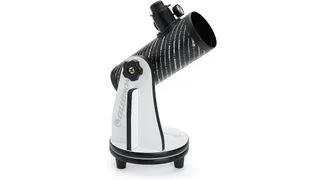 Celestron FirstScope 76 tabletop reflector telescope for kids and beginners
Celestron FirstScope 76 tabletop reflector telescope for kids and beginners
The Celestron FirstScope is a low-budget tabletop instrument to instill some sky-watching enthusiasm into your children.
Introducing the wonders of the night sky to children is a fantastic way to spark curiosity about the universe. The Celestron FirstScope 76 is an ideal first amateur telescope for young budding astronomers. This simple reflector telescope is designed for ease of use right out of the box – it comes fully assembled!
Its tabletop design and light weight (4.5 lbs / 2.04kg) make it perfectly sized for children. With a 76mm aperture and a fast f/3.95 focal ratio, it provides engaging views of the Moon and brighter celestial objects. While not offering highly magnified, sharp details like larger scopes, it delivers enough of a “wow factor” to inspire interest. It includes two basic eyepieces (4mm and 20mm). The build is surprisingly sturdy for its price. The main drawback is the lack of a finderscope, which makes locating objects challenging. We highly recommend purchasing an inexpensive red dot finder separately to improve the experience. Overall, this is a great, low-investment amateur telescope for casual viewing and encouraging a child’s interest in astronomy.
Specifications:
- Optical design: Reflector (Dobsonian tabletop)
- Mount type: Dobsonian (tabletop)
- Aperture: 2.99-inch / 76mm
- Focal length: 11.81-inch / 300mm
- Highest useful magnification: 180x
- Lowest useful magnification: 11x
- Supplied eyepieces: 4mm, 20mm
- Weight: 4.5 lbs / 2.04kg
| Attributes | Notes |
|---|---|
| Design | Good quality build for the price. |
| Performance | Provides a ‘wow factor’ for young observers. |
| Functionality | Optics struggle to pick out detail. |
Amateur Telescope FAQ
Selecting your first or next amateur telescope can raise many questions. Here are answers to some common queries.
How do I choose the right amateur telescope for me?
Choosing the right amateur telescope involves considering several factors: your budget, skill level, what you want to observe (planets, Moon, deep-sky objects, astrophotography), where you’ll be observing (backyard, dark sky sites), and your comfort level with technology and setup.
- Beginners: Look for user-friendly designs, perhaps with GoTo technology or intuitive smartphone apps. Refractors (like the Celestron Inspire 100AZ) or smaller computerized Maksutov-Cassegrains (like the Celestron NexStar 4SE or Astro Fi 102) are often good starting points.
- Enthusiasts: If you’re comfortable with manual mounts or want more aperture for deep-sky objects, larger reflectors (like a Dobsonian or the Celestron Astro Fi 130) offer great value. If you prefer automation, consider models like the NexStar 8SE or Astro Fi 130.
- Astrophotographers: Consider telescopes and mounts designed for imaging, such as those with equatorial mounts (like the Sky-Watcher Skymax 150 PRO paired with an EQ mount or the Celestron Advanced VX 8 EdgeHD) or smart telescopes with built-in cameras (like the Unistellar eQuinox 2 or Celestron Origin).
Don’t be afraid to start simple. A smaller, easy-to-use amateur telescope that you use often is far better than a large, complicated one that stays in storage. Reputable telescope dealers can also offer personalized advice.
What are the main types of amateur telescope?
There are three primary types of amateur telescope, distinguished by how they collect and focus light:
- Refractors: Use lenses to bend light. They offer crisp, high-contrast images, making them excellent for observing the Moon, planets, and double stars. They require minimal maintenance as the optics are sealed. However, larger apertures become expensive, and some (achromatic refractors) can exhibit false color fringing on bright objects.
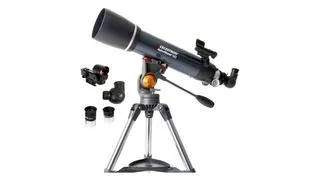 Celestron AstroMaster 102AZ refractor telescope and accessories
Celestron AstroMaster 102AZ refractor telescope and accessories - Reflectors: Use mirrors to collect and focus light. Newtonian reflectors (like the Celestron Astro Fi 130) are the most common type and offer the best value per inch of aperture, making large sizes more affordable. They are great for viewing fainter deep-sky objects due to their light-gathering ability. They may require occasional mirror alignment (collimation) and can be more open to dust. Dobsonian telescopes are a specific type of Newtonian on a simple, easy-to-use alt-azimuth mount, popular for their large apertures at low cost.
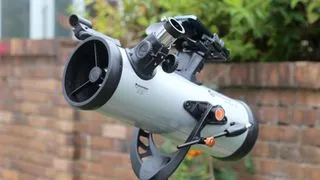 Celestron StarSense Explorer LT 114AZ reflector telescope
Celestron StarSense Explorer LT 114AZ reflector telescope - Catadioptrics (Compound): Combine both lenses and mirrors (e.g., Schmidt-Cassegrain and Maksutov-Cassegrain like the Celestron NexStar 4SE, 8SE, Evolution 9.25, Sky-Watcher Skymax 150 PRO, Celestron Astro Fi 102). They use a corrector plate (lens) at the front and mirrors to fold the light path, resulting in a compact, portable design with long focal lengths, ideal for planetary and deep-sky observation. They are versatile but generally more expensive than reflectors of similar aperture.
What is a finderscope on an amateur telescope?
A finderscope is a small, low-magnification telescope or sight mounted parallel to your main amateur telescope. Its purpose is to help you locate celestial objects easily. Because the main telescope has a narrow field of view (you see only a tiny patch of sky), it can be difficult to point it accurately at a specific star or planet.
Image 1 of 1
 Red dot finderscope attached to a Celestron Starsense Explorer 8-inch Dobsonian telescope
Red dot finderscope attached to a Celestron Starsense Explorer 8-inch Dobsonian telescope
A finderscope attached to a telescope may look like this.
A finderscope has a much wider field of view. You first aim the finderscope at your desired target (often centering it using crosshairs or a red dot). Once the object is centered in the finderscope, it should then be visible in the eyepiece of your main amateur telescope. There are different types, including simple red dot sights and magnified finderscopes, some of which provide an “erect” or “correct” image that isn’t upside down or backward.
What do Aperture, Magnification, and Focal Length mean for an amateur telescope?
These are key terms when discussing the performance of an amateur telescope:
- Aperture: This is the diameter of the main light-gathering element – either the objective lens (refractor) or the primary mirror (reflector/catadioptric). Aperture is the most important specification because it determines how much light the telescope collects and how much fine detail it can resolve. A larger aperture gathers more light, allowing you to see fainter objects (like distant galaxies) and provides higher resolution, revealing finer details (like planetary features or lunar craters).
- Focal Length: This is the distance from the objective lens or primary mirror to the point where the light converges to form an image (the focal point). A longer focal length generally results in higher potential magnification, while a shorter focal length provides a wider field of view. It’s usually measured in millimeters (mm).
- Magnification: This is how much larger an object appears when viewed through the telescope compared to the naked eye. Magnification is calculated by dividing the telescope’s focal length by the focal length of the eyepiece being used. For example, a telescope with a 1000mm focal length used with a 10mm eyepiece provides 100x magnification (1000 / 10 = 100). While high magnification sounds appealing, the usable magnification is limited by the telescope’s aperture and the observing conditions (atmospheric steadiness). Too much magnification with a small aperture or turbulent air will result in a blurry image.
Image 1 of 1
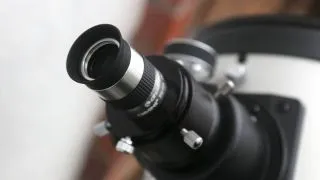 Close-up view of the eyepiece on a Celestron Starsense Explorer 8-inch Dobsonian amateur telescope
Close-up view of the eyepiece on a Celestron Starsense Explorer 8-inch Dobsonian amateur telescope
Telescope eyepieces can be changed to adjust the magnification of a telescope.
Magnification: How do amateur telescope eyepieces work?
Eyepieces are removable lenses inserted into the focuser of your amateur telescope. They take the light collected and focused by the main optics and magnify the image before it reaches your eye.
Each eyepiece has its own focal length, measured in millimeters. The general rule is: shorter eyepiece focal length = higher magnification, and longer eyepiece focal length = lower magnification.
By using different eyepieces, you can change the magnification of your telescope. For instance, if your telescope has a 1000mm focal length:
- A 25mm eyepiece gives 1000mm / 25mm = 40x magnification.
- A 10mm eyepiece gives 1000mm / 10mm = 100x magnification.
- A 5mm eyepiece gives 1000mm / 5mm = 200x magnification.
Most amateur astronomers build a collection of eyepieces to provide a range of magnifications for different observing targets and conditions. Low power (long focal length eyepieces) are great for wide views to find objects or look at large nebulae/star clusters. Medium power is good for general observing. High power (short focal length eyepieces) are used for detailed views of the Moon and planets, but only when the atmosphere is steady (good “seeing”).
Choosing the right amateur telescope is the first exciting step into exploring the cosmos. Each instrument offers a unique window to the universe, promising countless nights of wonder and discovery. Whichever path you choose, from a simple tabletop scope to a sophisticated GoTo system, the journey of amateur astronomy is a deeply rewarding one. So, find the telescope that calls to you, step outside, and prepare to be amazed by the incredible beauty above.
